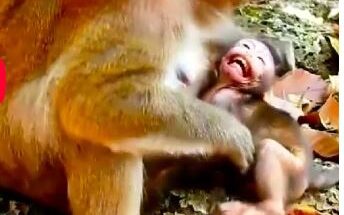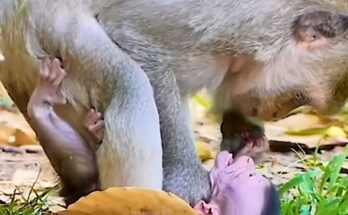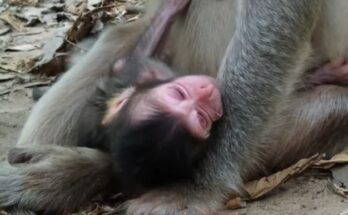In the heart of the forest, where monkey troops thrive in intricate social groups, one of the most tender and complex processes unfolds quietly between a mother and her growing baby: the gradual act of weaning. For a baby monkey, nursing is not only a source of nourishment but also a deep source of comfort and emotional security. And for the mother, the decision to wean is not abrupt or unfeeling—it is thoughtful, patient, and often filled with subtle negotiations.
As the baby begins to grow, typically around several months of age (depending on the species), the mother starts showing signs that the time has come to reduce nursing. This is a crucial step in development, allowing the infant to learn independence, explore solid foods, and gradually integrate more into troop life. But for many infants, letting go of milk isn’t easy. Clinging tightly to their mothers, they attempt to nurse even when milk is scarce or when their mother tries to redirect their attention.
Rather than responding with force, mother monkeys often use gentle strategies to signal change. She might shift her body or move away when the infant tries to nurse. She may distract the baby by encouraging play, grooming, or guiding it toward solid food. These small rejections are not cruel—they are part of a natural and loving process. Weaning is about more than physical nourishment; it’s about fostering growth, self-reliance, and emotional maturity.
Observers frequently see this gentle push-and-pull play out over weeks or even months. One moment, the mother allows her baby to latch on briefly. The next, she gently pulls away or walks a short distance, prompting the baby to follow and redirect its focus. The infant may protest with whimpers or cling harder, but the mother remains consistent, offering reassurance through touch and presence without giving in entirely.
It’s important to note that weaning doesn’t sever the bond between mother and child. In fact, the emotional connection often becomes more nuanced. As the baby becomes more physically capable—learning to climb, forage, and interact socially—the mother supports this independence while continuing to offer comfort through grooming and close contact. The weaning process becomes a dance of love and patience, with the mother encouraging her child to step into the wider world.
This period can be bittersweet. The mother, whose every movement once revolved around feeding her baby, is beginning to prepare for a new phase—either her own rest or, eventually, the care of another infant. Meanwhile, the baby is learning that it can survive and thrive even when its favorite source of comfort is no longer always available.
In watching a mother monkey gently guide her baby through this transition, we see the deep intelligence and emotional depth that exists in primate parenting. Weaning, while challenging, is a quiet rite of passage. It’s a reminder that love, in its truest form, isn’t just about giving—it’s also about teaching when to let go. Would you like a version of this suitable for narration or a children’s book adaptation?


